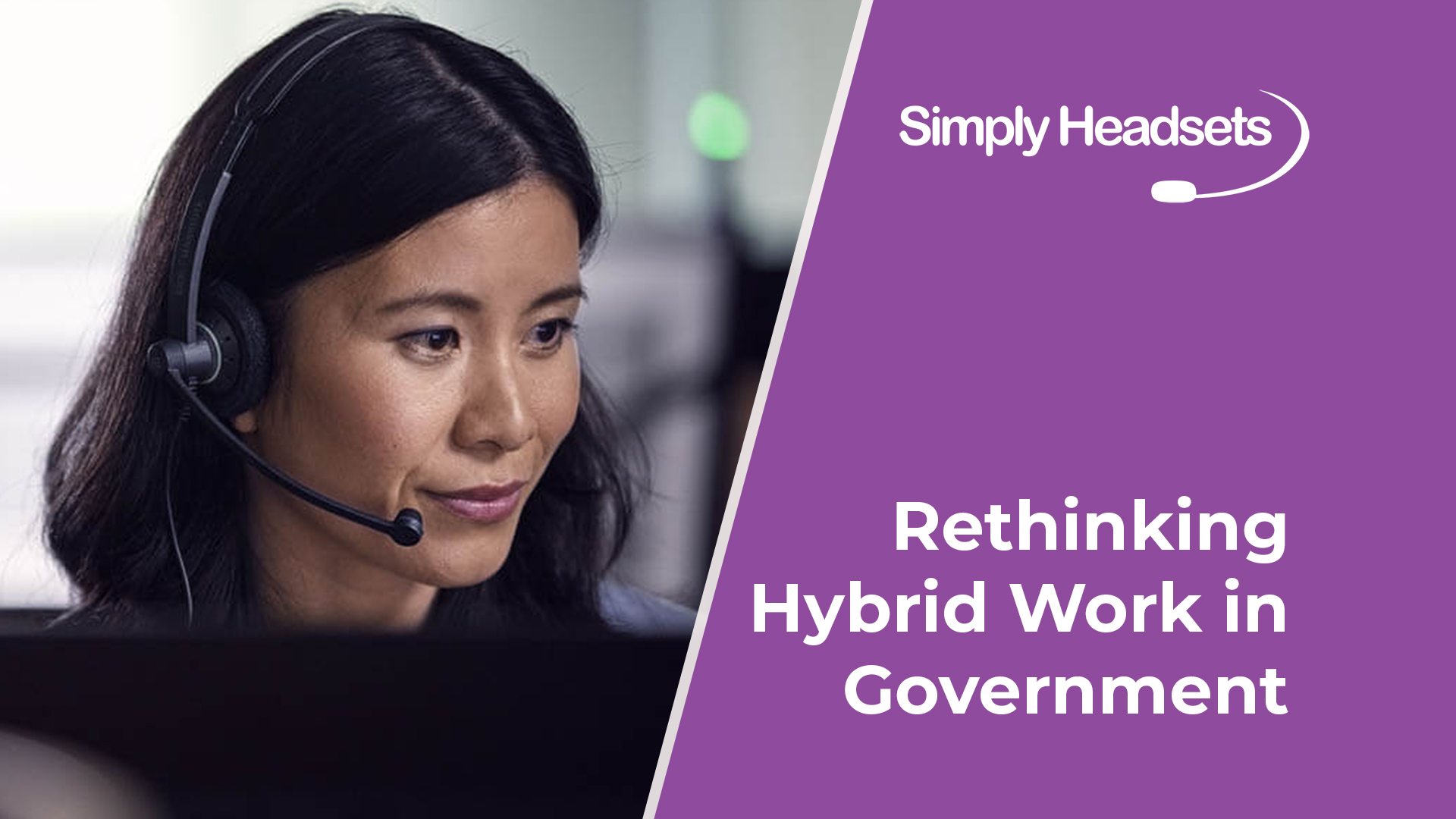Rethinking Hybrid Work in Government Institutions

The workforce is transforming.
75% of workers worldwide say they want to work from anywhere, which means two things. Firstly, employees want to make their own decisions about when, where, and how they work. Secondly, unless you want to be left behind and miss out on hiring highly skilled workers in your organisation, you need to adapt to these rapid changes.
The future workforce may work from the office, home, or somewhere completely different. This means government workers will no longer be confined to an office from 9 am till 5 pm. This creates a few issues that will be addressed in the following article.
How do you rethink the relationship between your employees and other organisations or employees and their clients? What management strategies need to be implemented to make the hybrid working experience a smooth transition for both employers and staff? And what role will audio and video technology play in this transition?
Post Contents [hide]
- Why Hybrid Work is the Future
- Three Takeaways From Remote and Hybrid Work in Government
- Effective Ways to Manage Hybrid Teams
- Professional Technology For a Hybrid Public Sector
- Inclusive Management and Secure Technology is the Key to Hybrid Work Success
- Browse our Full Range of Secure Headsets and Video Conferencing Solutions
Why Hybrid Work is the Future
According to a recent poll, 88% of workers in Australia would like to work part of the week at home, and 60% would like a hybrid mix where they work at home or in the office. That’s an astonishing figure. If we approach these figures from another angle, it tells us that a mere 12% don’t want to work part of the week at home. Interestingly though, the same survey tells us that workers report that only 49% of their employers would agree for them to work in a hybrid capacity. This could be interpreted by saying that the workforce is changing rapidly, but organisations are not changing alongside them at the same pace. This could be because of a lack of infrastructure or technology, a worry about decreasing productivity or a lack of trust in employees.
To ensure that your organisation can adequately serve its constituents, management strategies need to be adapted to suit the hybrid working future. This will ensure that your organisation is employing the best professionals available and that they are fostering a culture of change and inclusivity.

Three Takeaways From Remote and Hybrid Work in Government
Remote Workers Can be Just as Productive as Office Workers
Overnight, workforces worldwide were forced to implement a remote working system. Understandably, some managers and leaders worried that the impact on productivity would be negative. Maybe they imagined their workforce waking at 10 am, putting their feet up and watching streaming services all day, but the research showed something completely different. The drastic change in their work environment allowed employees to focus on the work that mattered, often with much less interruption than at the office. It also freed them up to spend more time interacting with clients and business partners, which increased productivity.
Evaluate an Employee's Output, Not Their Time Spent in the Office
Just because there isn’t an employee's physical presence doesn’t mean they’re not getting anything done. When management can talk face-to-face with employees and engage with them whenever they wish, it tends to inform them of their employee's competency. But what matters at the end of the day? The actual work employees deliver. If targets are being hit and they are meeting KPIs, a hybrid worker is doing their job. As a manager, you need to find ways to evaluate both in-office and hybrid staff fairly and equally.
Technology is Essential to Ensuring Hybrid Work in Government Success
The rise of Zoom and Microsoft Teams has proven that there are more ways to execute tasks and optimise our time. The type of technology used with these, and other applications, determines whether a remote or hybrid employee will have equal opportunities at work. Management is responsible for researching which tools will be most beneficial for their employees - and therefore, their organisation. This will produce optimal productivity and an authentic flexible working experience.

Effective Ways to Manage Hybrid Teams
The best way to stall productivity is to have a strict, regimented program for hybrid work employees to follow. Having too many rules will make the experience frustrating for them and time-consuming for you. Most employees are more productive in an autonomous environment, and when they’re given some flexibility, it helps them to thrive. Your hybrid team is no different.
Implement a Hybrid Work Strategy Based on Trust
We know this isn’t as easy as it sounds because, to some extent, you must let go of some control and put yourself on the line. This comes at some risk to yourself because trust means that you essentially have to rely on your employees to do the right thing. But if you want to cultivate a culture of inclusivity, you’ll need a willingness to trust your employees because trust builds a sense of safety, and it is essential to an effective hybrid team. Trust builds trust. Employees will trust you back if they know that you trust them, and mutual trust boosts productivity. Consider some trust-building and team-building exercises as part of your strategy.
Invest in Technology to Connect With Your Hybrid Work Team
During the transition to hybrid work in Government, some companies lacked the digital maturity to implement a remote working strategy effectively. Employees who relied on technology daily to effectively communicate with their management or clients, and who needed the right technology to complete their daily tasks, often found that they lacked the right tools. Having outdated or wrong technology might stop your hybrid working strategy dead in its tracks. Compare an employee who tries to video call only to have constant camera and audio dropouts to one who doesn’t have to think about what headsets they’re wearing or worry about the video camera they’re using due to their seamless technology experience. The latter will be much more productive.

Professional Technology For a Hybrid Public Sector
It is wise to be secure with all communications, but even more so in the public sector. Government institutions often share sensitive information and become the targets of cyber attacks.
Wireless Headsets Built for Privacy and Security
Thankfully, some headsets have outstanding security features across their communication points, including encryption, authentication and pairing. Suppose you’re unsure whether your headsets meet your specific privacy and security standards. In that case, you need to ask if they have been independently tested and verified for strict government security requirements and if those features always remain relevant and are regularly updated. Some headsets offer an extra layer of security, including high-quality noise-cancelling microphones that filter out background noise and conversations. This ensures no sensitive information is transmitted from the user's side of the call, which is of extreme importance when evaluating your hybrid work in government strategy.
Edge AI for Secure Video Communications
We don’t communicate exclusively through audio devices like headsets. Video conferencing is now a central fixture in our working lives and will continue to be so - but with increased complexity.
Increased data collection creates a need for that data to be protected. When you’re on a video call, your data and surroundings are captured. If you’re in a government office that often shares sensitive information, your background data captured in the video frame of your video calls will be sent to the cloud for processing - even if you use features that obscure your background.
Edge AI (or on-device AI) can collect and process data on the user's device, eliminating the reliance on cloud processing and limiting the transfer points where sensitive personal data can become vulnerable or compromised.
The benefit of this is that data from sensitive and confidential calls can be secure from end to end.
Edge AI will provide a much more secure communications experience for your organisation and must be seriously considered for government institutions with a workforce of hybrid workers communicating sensitive data or information.

Inclusive Management and Secure Technology is the Key to Hybrid Work Success
For Hybrid Work in Government success, two key areas need to be addressed. Strict policies and procedures may work in an office environment, but sets of basic principles work better for a hybrid working strategy.
Inclusive Management
Communications are becoming more complex now that people can work anywhere. This means that now more than ever, managers and other decision-makers need to consider how their hybrid workforce will be impacted by wellbeing and employee satisfaction. Building a strong organisational culture is imperative as all employees must feel valued and empowered. This will be helped if they are provided with the necessary tools.
Secure Technology
Inclusive management strategies will not work without secure technology to complement them. When working across multiple locations, your employees will require better audio and video techniques which will give them - and your organisation - a more secure communications experience. You not only need to allow and trust your workers to work in a hybrid capacity, but they also need the right professional tools and technology to go with it. This enables employee flexibility and interactive human connection but doesn’t compromise your organisation's security.

Browse our Full Range of Secure Headsets and Video Conferencing Solutions
Simply Headsets stock a wide range of headsets that go beyond the standard level of security and offer the highest level of protection. If you’re looking for headsets or video conferencing gear for your hybrid staff, we’ve got you covered, and all our products are backed up with free lifetime support. Give us a call today. By providing you with the right headsets and video conferencing tools, we can help you to lead your successful hybrid workforce.



